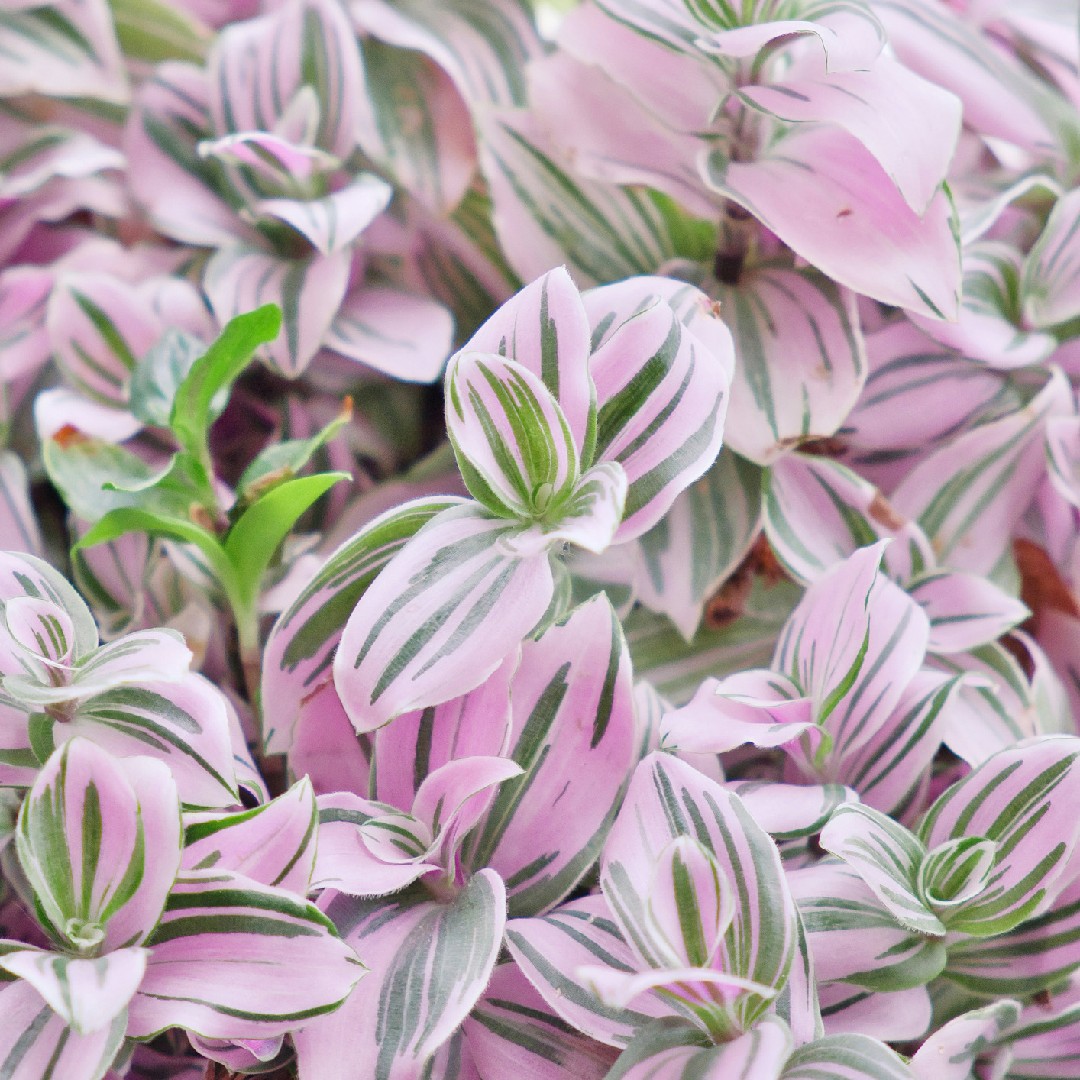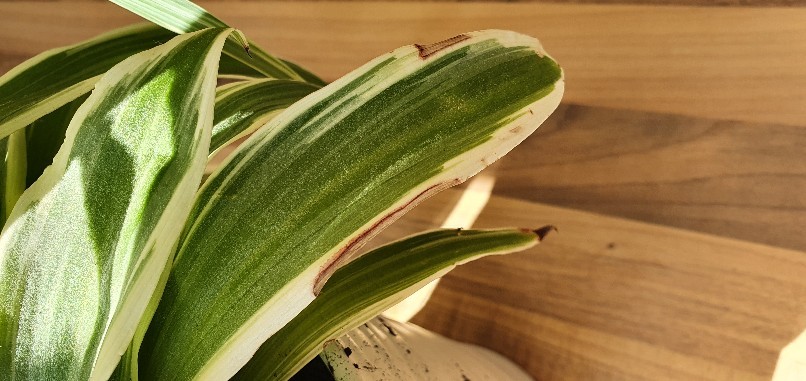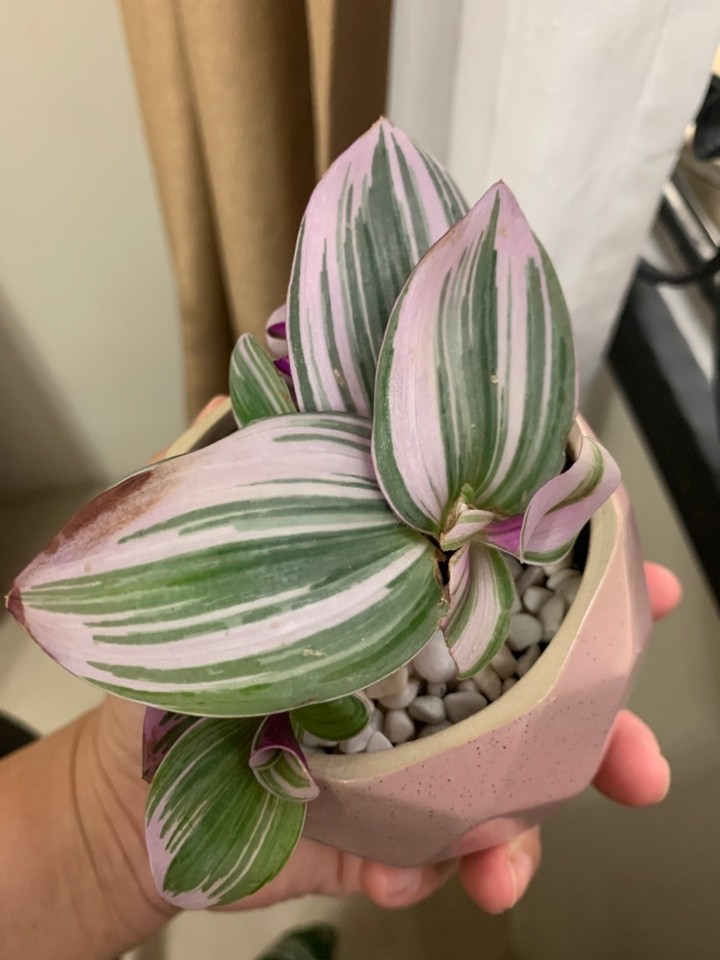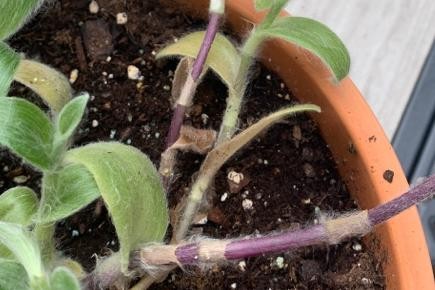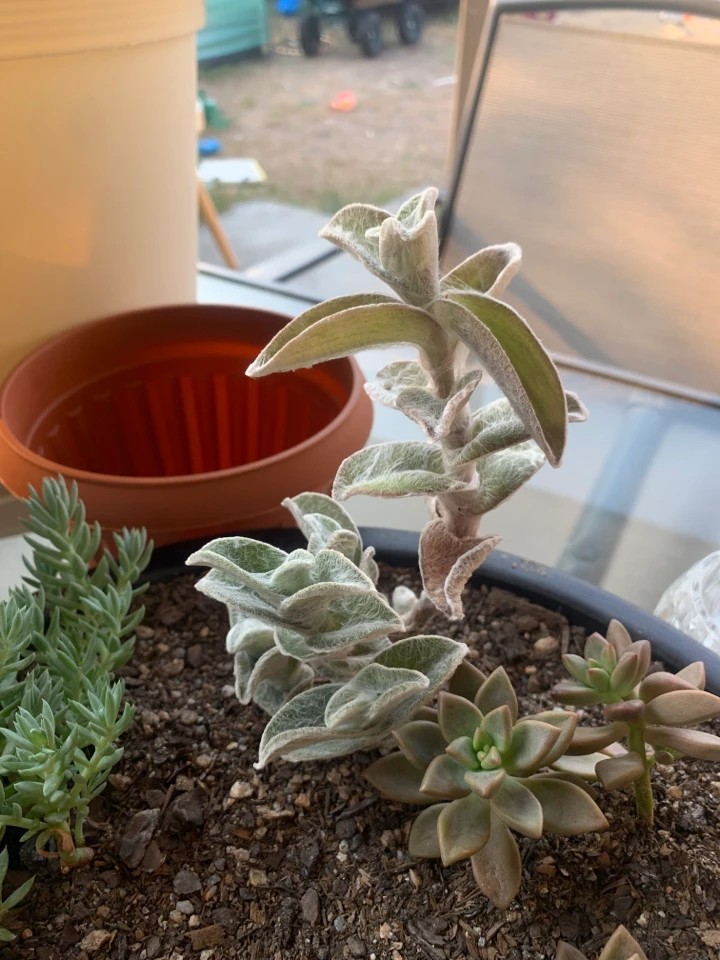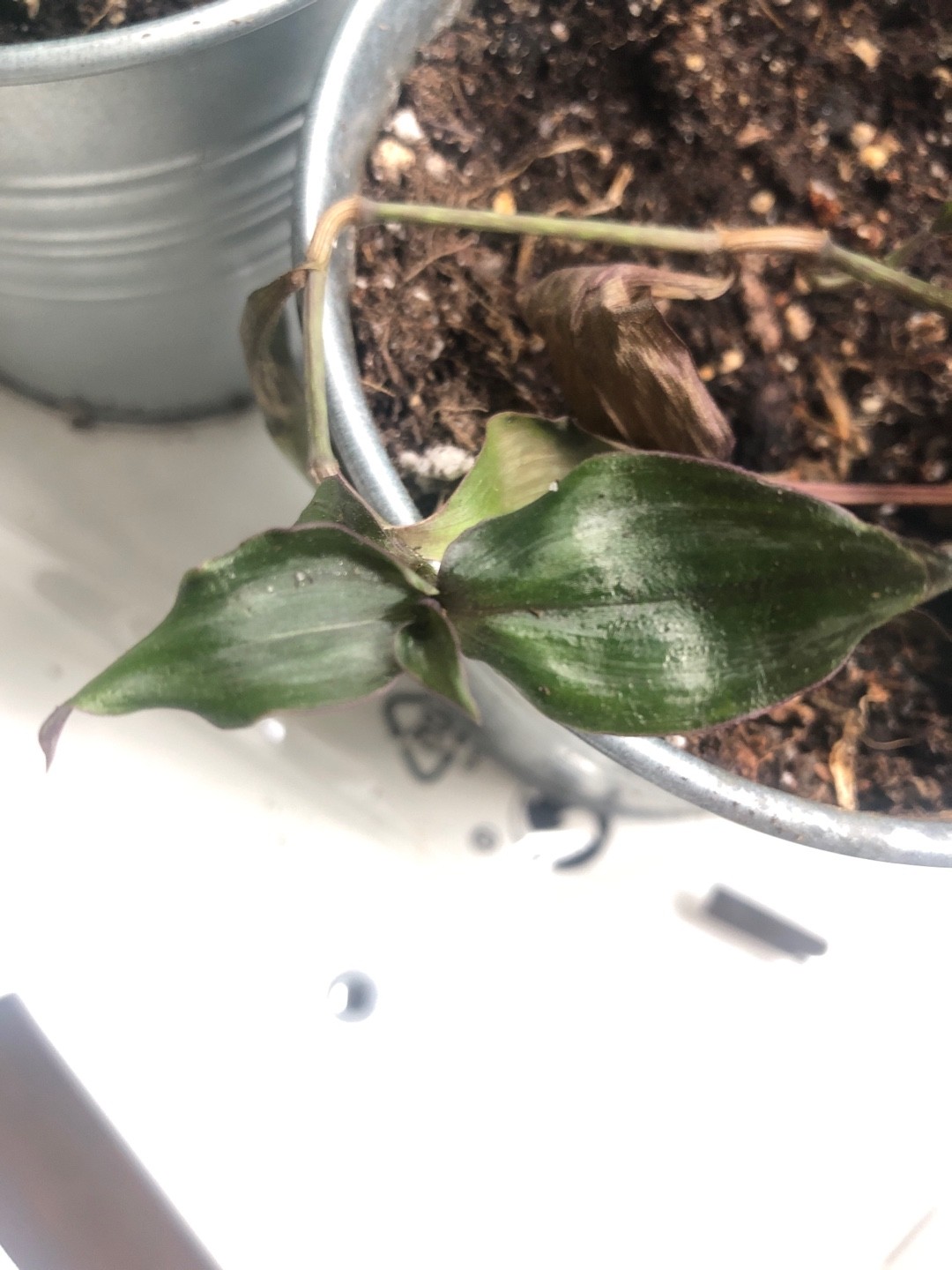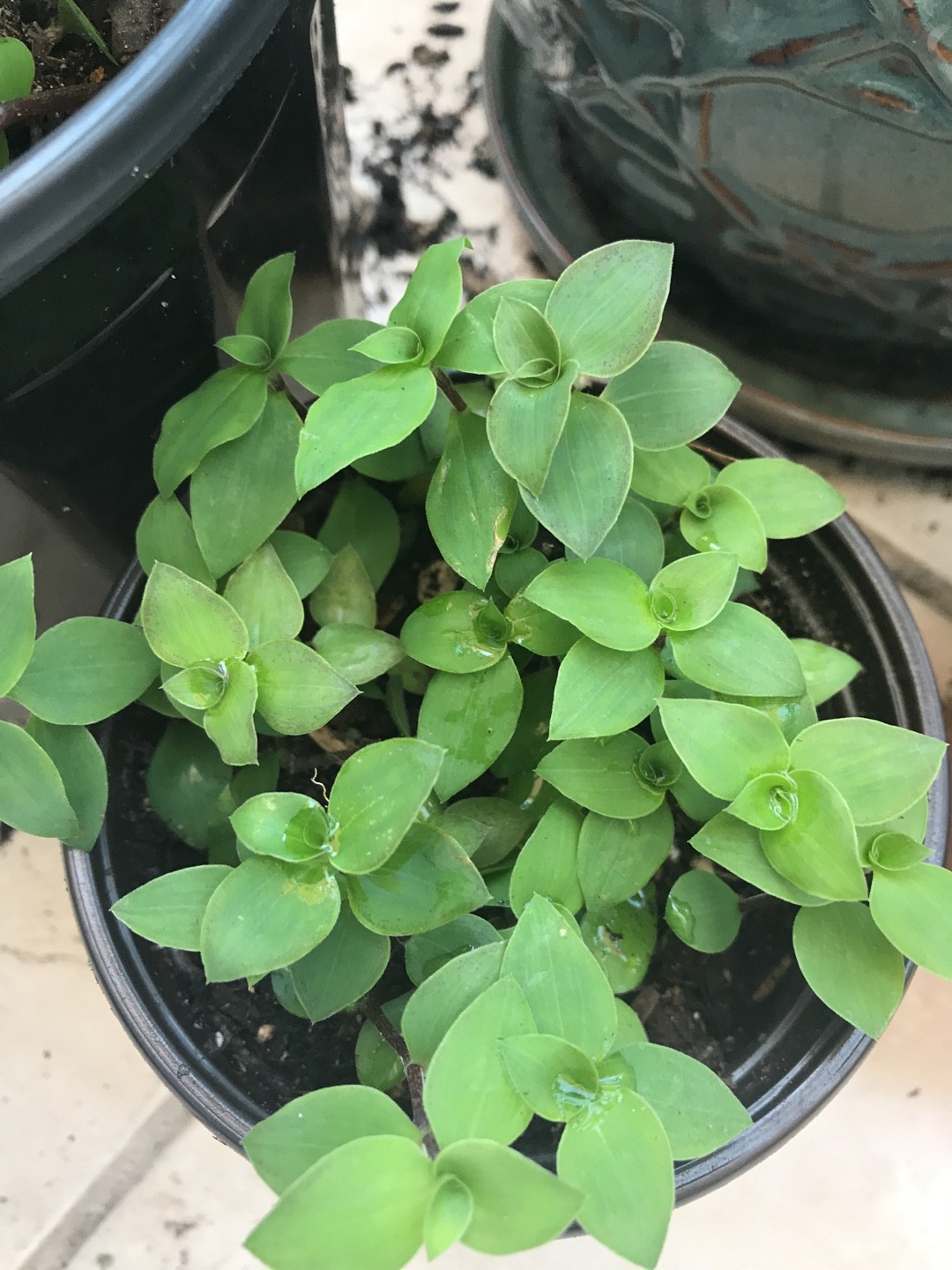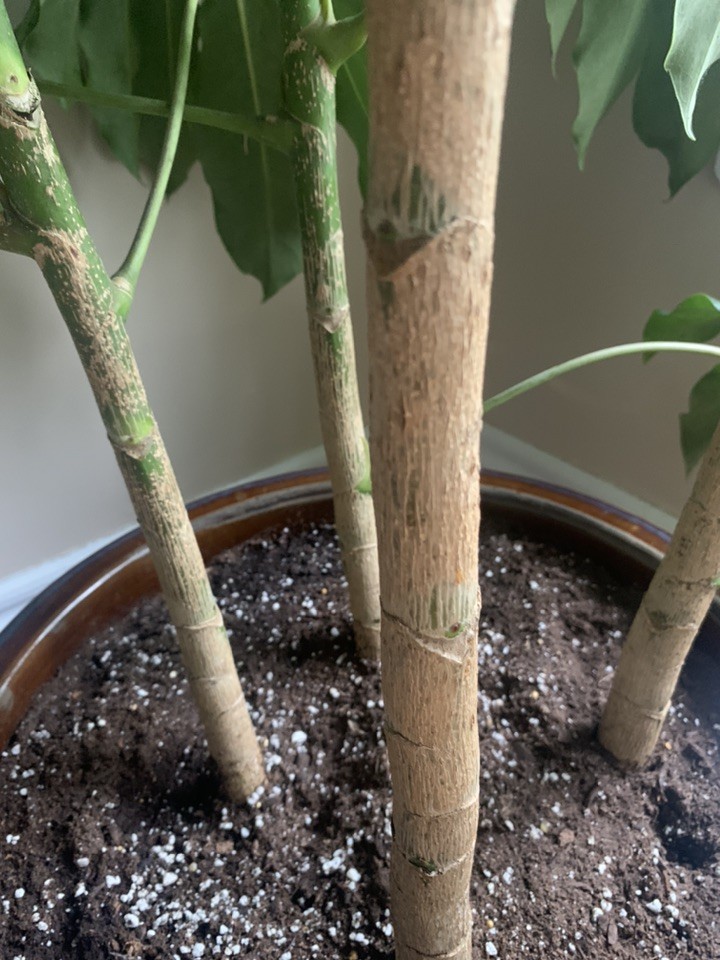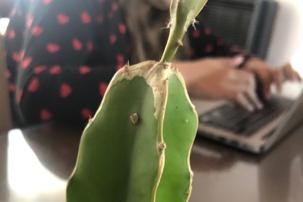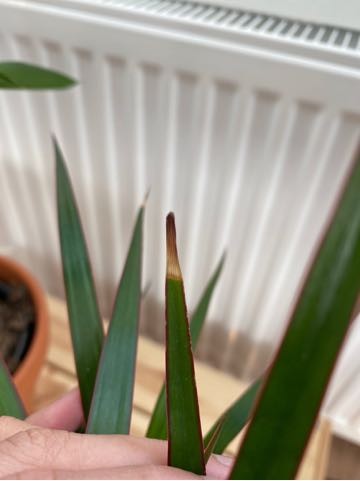What is the best way to water my Tradescantia Nanouk?
When watering the Tradescantia Nanouk, you should aim to use filtered water that is at room temperature. Filtered water is better for this plant, as tap water can contain particles that are harmful to its health. The reason that the water should be at room temperature or slightly warmer is that the Tradescantia Nanouk comes from a warm environment, and cold water can be somewhat of a shock to its system. Also, you should avoid overhead watering for this plant, as it can cause foliage complications. Instead, simply apply your filtered room temperature water to the soil until the soil is entirely soaked. Soaking the soil can be very beneficial for this plant as it moistens the roots and helps them continue to spread through the soil and collect the nutrients they need.
![more]()
What should I do if I water my Tradescantia Nanouk too much or too little?
Both overwatering and underwatering will be detrimental to the health of your Tradescantia Nanouk, but overwatering is a far more common issue. When this species receives too much water, its stems and leaves may begin to wilt and turn from green to yellow. Overwatering over a prolonged period may also lead to diseases such as root rot, mold, and mildew, all of which can kill your plant. Underwatering is far less common for the Tradescantia Nanouk, as this plant has decent drought tolerance. However, underwatering remains a possibility, and when it occurs, you can expect to find that the leaves of your Tradescantia Nanouk have become brittle and brown. It is crucial that you notice the signs of overwatering as soon as possible when caring for your Tradescantia Nanouk. Some of the diseases that arise from overwatering, such as root rot, may not be correctable if you wait too long. If you see early signs of overwatering, you should reduce your watering schedule immediately. You may also want to assess the quality of soil in which your Tradescantia Nanouk grows. If you find that the soil drains very poorly, you should replace it immediately with a loose, well-draining potting mix. On the other hand, if you find signs that your Tradescantia Nanouk is receiving too little water, all you need to do is water more regularly until those signs have subsided.
![more]()
How often should I water my Tradescantia Nanouk?
If your plant is in a pot. The most precise way to decide whether your Tradescantia Nanouk needs water is to plunge your finger into the soil. If you notice that the first two to three inches of soil have become dry, it is time to add some water. If you grow your Tradescantia Nanouk outdoors in the ground, you can use a similar method to test the soil. Again, when you find that the first few inches of soil have dried out, it is time to add water. During the spring and early fall, this method will often lead you to water this plant about once every week. When extremely hot weather arrives, you may need to increase your watering frequency to about twice or more per week. With that said, mature, well-established the Tradescantia Nanouk can show an admirable ability to withstand drought.
![more]()
How much water does my Tradescantia Nanouk need?
When it comes time to water your Tradescantia Nanouk, you should not be shy about how much water you give. With the first two to three inches of soil dry, this plant will appreciate a long and thorough watering. Supply enough water to soak the soil entirely. The amount of water you add should be enough to cause excess water to flow through the drainage holes at the bottom of your pot. If you don’t see excess water draining from the pot, you have likely underwatered your plant. But do not let the water accumulate inside the soil, which will be very dangerous to the plant as well. Alternatively, a lack of water draining through the pot could indicate poorly draining soils, which is detrimental to the health of this plant and should be avoided. If the plant is outside, 1 inch of rain per week will be sufficient.
![more]()
How should I water my Tradescantia Nanouk at different growth stages?
The water needs of the Tradescantia Nanouk can change depending on growth stages as well. For example, when your Tradescantia Nanouk is in the first few years of its life, or if you have just transplanted it to a new growing location, you will need to give more water than usual. During both of those stages, your Tradescantia Nanouk will put a lot of energy towards sprouting new roots that will then support future growth. For those roots to perform their best, they need a bit more moisture than they would at a more mature phase. After a few seasons, your Tradescantia Nanouk will need much less water. Another growth stage in which this plant may need more water is during the bloom period. Flower development can make use of a significant amount of moisture, which is why you might need to give your Tradescantia Nanouk more water at this time.
![more]()
How should I water my Tradescantia Nanouk through the seasons?
The Tradescantia Nanouk will have its highest water needs during the hottest months of the year. During the height of summer, you may need to give this plant water more than once per week, depending on how fast the soil dries out. The opposite is true during the winter. In winter, your plant will enter a dormant phase, in which it will need far less water than usual. In fact, you may not need to water this plant at all during the winter months. However, if you do water during winter, you should not do so more than about once per month. Watering too much at this time will make it more likely that your Tradescantia Nanouk will contract a disease.
![more]()
What's the difference between watering my Tradescantia Nanouk indoors and outdoors?
It is most common to grow the Tradescantia Nanouk indoors for any gardener that does not live in temperate and tropical regions. Those gardeners should consider the fact that soil in a container can dry out a bit faster than ground soil. Also, the presence of drying elements such as air conditioning units can cause your Tradescantia Nanouk to need water on a more frequent basis as well. if you planted it outside. When that is the case, it’s likely you won’t need to water your Tradescantia Nanouk very much at all. If you receive rainfall on a regular basis, that may be enough to keep your plant alive. Alternatively, those who grow this plant inside will need to water it more often, as allowing rainwater to soak the soil will not be an option.
![more]()
Is pruning necessary for my Tradescantia Nanouk?
It is helpful to lightly prune this plant periodically during the spring and summer. When performing this light pruning, you should search for leaves that have wilted, become discolored, show signs of disease, or have died completely. Remove dead or damaged leaves by cutting their petioles, or trimming off stems that have died. This will increase the light and ventilation of the plant and help it to grow. Some gardeners also choose to remove the flower buds of the Tradescantia Nanouk. However, removing flower buds before they open is a strictly aesthetic decision that will emphasize the beauty of this plant’s showy leaves.
![more]()
When should I prune my Tradescantia Nanouk?
You can prune your Tradescantia Nanouk any time you notice dead, diseased, or damaged leaves during the growing season. Once you notice such a leave, locate an unwanted leaf, then follow its stem all the way to the bottom of petiole. Removing dead stems will increase the light and ventilation of the plant and help it to grow. you can cut its stem just above the soil’s surface to remove it. Such pruning can take place as needed during spring and summer. Also, this plant can bloom any time between spring and fall, and some gardeners choose to remove flower buds before they have a chance to open. Removing unopened flower buds allows this plant to focus most of its growing energy on its beautiful leaves. However, pruning in this manner does not necessarily influence the plant’s overall health.
![more]()
How do I prune my Tradescantia Nanouk?
Pruning the Tradescantia Nanouk is as easy as waiting until you notice dead or damaged leaves on your plant. When you recognize these leaves, equip yourself with a pair of sharp and sterile hand pruning shears. Hand pruning shears will work best as larger tools like loppers will not be well suited to the precise cuts you need to make. Once you have a proper set of pruning tools, locate an unwanted leaf, then follow its stem all the way to the bottom of petiole. Removing dead stems will increase the light and ventilation of the plant and help it to grow. Cut the stem just above where it exits the soil to remove it entirely. If you wish to stop this plant from flowering, you can use the same pruning shears to remove any buds before they open. Finally, you may prefer to just trim off dead or damaged portions of the plant, including deadheading spent flowers, to keep it looking its best. This can be done at any time of year. Diseased or damaged stems should be cut right at the soil line and removed completely. Blooms should be cut off just below the flower head.
![more]()
What should I do after pruning my Tradescantia Nanouk?
Since pruning for the Tradescantia Nanouk should take place periodically throughout the season, what you do after pruning can vary. For instance, if you prune to remove selected leaves and stems from your Tradescantia Nanouk, you won’t need to do anything except continue your regular maintenance routine. At times, you may choose to remove healthier leaves and include them in a display of cut flowers and foliage. However, there is no crucial maintenance task to perform for this plant after typical pruning. The only thing to note is that when watering after pruning, you need to be careful not to touch the wound to prevent fungus from infecting the plant through the fresh wound. Placing Tradescantia Nanouk in a well-ventilated location will also help the wounds to dry out and heal in time. The timely replenishment of Tradescantia Nanouk after pruning will help the Tradescantia Nanouk to recover as soon as possible.
![more]()
Are there any important tips when pruning my Tradescantia Nanouk?
For your major pruning, use sharp pruning sheers that will make clean cuts to avoid damaging your plants. As you are pruning your Tradescantia Nanouk, step back occasionally to check the appearance of the plant to make sure it has the shape you want and that you are pruning it symmetrically. If the overall growth of the plant is weak, the flowers need to be pruned back in time for flowering to be able to save nutrients for leaf growth and allow the plant to grow more vigorously.
![more]()
How many hours of sunlight does Tradescantia Nanouk need to grow?
Tradescantia Nanouk requires about 3-6 hours of direct sunlight each day to thrive. However, it also needs some shade during the hottest parts of the day to prevent sun damage. Morning sunlight is ideal for Tradescantia Nanouk, but it can also tolerate some afternoon sun if the temperature is not too hot. To provide the perfect balance of sunlight, try planting Tradescantia Nanouk in an area that gets partial sun, such as under a tree or on the east side of a building.
![more]()
What will happen if Tradescantia Nanouk doesn’t get enough sunlight?
If Tradescantia Nanouk is exposed to too much direct sunlight, its leaves may turn yellow, dry out, or even burn. You may also notice that the plant wilts or becomes stunted. To prevent sun damage, make sure to give Tradescantia Nanouk some shade during the hottest parts of the day. You can use a shade cloth or plant Tradescantia Nanouk near taller plants that can provide some natural shade.
![more]()
What will happen if Tradescantia Nanouk gets too much sunlight?
If Tradescantia Nanouk doesn't get enough sunlight, it may grow tall and lanky, with sparse foliage. The leaves may also turn yellow or pale green, indicating that the plant is not producing enough chlorophyll due to lack of sunlight. To remedy this, try moving Tradescantia Nanouk to a sunnier spot, or prune nearby foliage to allow more light to reach the plant.
![more]()
Why do I need to fertilize my Tradescantia Nanouk?
All plants rely on soil nutrients to facilitate their growth, and the Tradescantia Nanouk is no exception. However, it is not always a guarantee that the soil in which your plants grow will have all of the nutrients required. Fertilization and soil amendments help ensure that the plants in your garden not only have the basic nutrients they need but also that they get the nutrients that are specifically necessary to them. Tradescantia Nanouk needs fertilizer to ensure that its roots and stems continue to develop in a healthy way throughout the growing season. Fertilization will also help a Tradescantia Nanouk a set of leaves that looks fantastic, which is especially important for this plant since its foliage is its main point of ornamental appeal.
![more]()
When is the best time to fertilize my Tradescantia Nanouk?
A Tradescantia Nanouk will need the greatest amount of fertilizer during the seasons in which it is actively growing. This active growth phase typically spans most of the months that make up spring, summer, and early fall. Once winter ends, you should plan to feed your Tradescantia Nanouk about once every two to four weeks. Continue feeding at this rate until the fall months arrive. Once fall arrives, you can reduce your fertilization rate, reducing the amount of fertilizer you give gradually until you cease feedings entirely in anticipation of winter, when the Tradescantia Nanouk will have far less active growth.
![more]()
When should I avoid fertilizing my Tradescantia Nanouk?
Throughout most of the year, including spring, summer, and most of the fall, you should continue feeding your Tradescantia Nanouk regularly. The only exception to this is if you notice that your Tradescantia Nanouk has received too much fertilizer or if you have managed to fertilize your Tradescantia Nanouk incorrectly, causing fertilizer burn or some other issue that you'll need to remedy before returning to a regular feeding schedule. The only time of year when you should not fertilize a Tradescantia Nanouk is during winter. If you grow this plant indoors in an area where the winters are cold, it will enter a dormant phase during the winter. Feeding this plant during its dormant phase is not only unnecessary and unhelpful to this plant's growth, but it is also very likely to cause fertilizer burn.
![more]()
What type of fertilizer does my Tradescantia Nanouk need?
The fertilizer for a Tradescantia Nanouk has a specific blend of nutrients, each of which is present in relatively low amounts. An ideal fertilizer will have an N-P-K ratio of 3-1-2. However, a general-purpose fertilizer that has an even blend of nutrients can work well in some cases. Still, even when using a balanced fertilizer, the ratio number representing the volume of each nutrient should be at 10 or lower. The fertilizer you use can be either granular or liquid based. If you choose to use a liquid-based fertilizer, it is often best to dilute the strength by half. While there is not much downside to granular fertilizer, it is often most sensible to use liquid fertilizer, especially if you feed your Tradescantia Nanouk while you supply water.
![more]()
How do I fertilize my Tradescantia Nanouk?
The fertilizer that you purchase for your Tradescantia Nanouk will likely come with application instructions that you should follow in most cases. However, for a Tradescantia Nanouk, you should always fertilize just before or while you are watering the soil, as this will prevent the fertilizer from burning the plant's roots. If you use a slow-release granular fertilizer, you should sprinkle it on the soil and then provide water immediately after. If you use a liquid-based fertilizer, you should dilute it with water, apply it to the soil, then supply a bit more water. Diluting your fertilizer by at least half is especially important in spring and fall when the plant's growth is ramping up and decelerating, respectively.
![more]()
What happens if I fertilize my Tradescantia Nanouk too much?
Since it is advisable to fertilize your Tradescantia Nanouk every few weeks throughout the growing season, overfertilization is not often an issue. However, it remains possible for this to occur. If you overfertilize your Tradescantia Nanouk, you may notice accumulations of excess fertilizer on the soil’s surface and foliage discoloration. Fertilizer burn is the most common issue you should worry about when feeding a Tradescantia Nanouk. This issue occurs when you overfertilize, fail to dilute your fertilizer, or when don’t water during and after fertilization. In any of those cases, the fertilizer can draw moisture out of your plant’s roots, causing it to dry out. Often, fertilizer burn will manifest with browning and yellowing of this plant’s leaves.
![more]()

